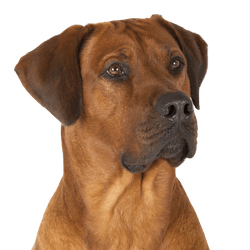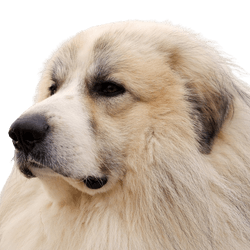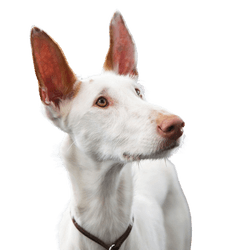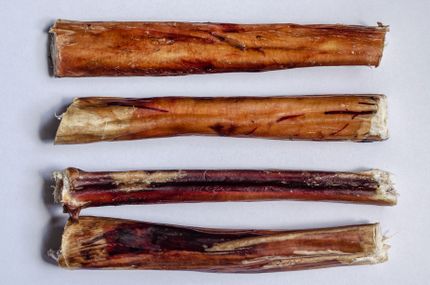
Giant Schnauzer Breed description: Character & Co
Giant Schnauzer
Facts & Origin
What is the origin of the Giant Schnauzer?
In the past, Schnauzers were seen throughout Central Europe as companions of carriages. They followed their owners countless kilometres through the country and made sure that none of their belonging would get stolen on the way. While the horses were in their stables in the evenings, the tireless dogs went to hunt for rats and mice. In addition, the ancestors of the breed were used as herding dogs for large herds of cattle. The four-legged friend owes its nickname "Beer-Schnauzer" to its occupation in southern Germany in the 19th century. At that time, the dogs were traveling in and around Munich with brewers who delivered their beer to customers by coach. It was also in the Bavarian capital that Giant Schnauzers were first presented at a dog show in 1909. Four years later, the stud book for the breed was established. Since the Giant Schnauzer was discovered as a military dog during World War I, it has proven its worth as a rescue and police dog. Since 1925, it is officially considered a service dog breed. In the 1930s, it was still the most popular among the Schnauzer breeds, but was replaced by the Miniature Schnauzer after the Second World War.
What are the breed characteristics of Giant Schnauzers?
The breed standard describes the Giant Schnauzer as a "defiant dog of respectable appearance". This hits the nail on the head, because your darling is a real powerhouse and has a lot of temperament. The largest Schnauzer breed wears the typical beard, which gives it a smart appearance. The smart eyes look at you from underneath the strongly pronounced eyebrows. Also typical are the high set triangular ears, which tilt forward. In former times, the tail of the Giant Schnauzer was docked, in Austria this has been forbidden since 2005. The tail is of medium length and is carried sabre or sickle shaped.

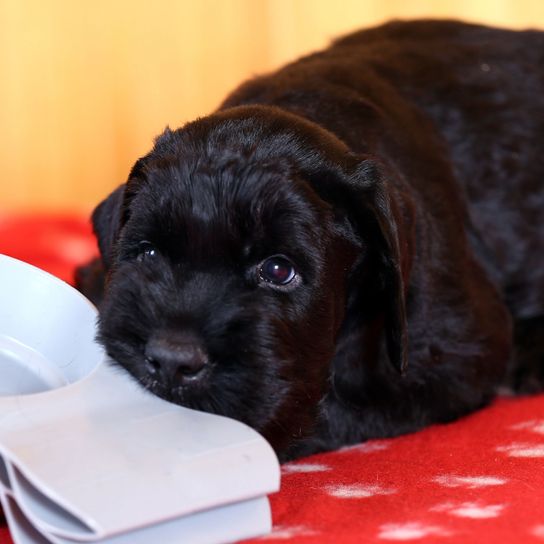


| Alternate Name | Schnauzer, Standard Schnauzer |
| Origin | Germany |
| Life expectancy | 12 - 15 years |
| Care requirements | high-maintenance |
| Activity level | high |
| FCI group | Pinscher and Schnauzer type |
| AKC group | not recognised |
| KC group | not recognised |
Giant Schnauzer mixes
Attitude, character and temperament of the breed
What are typical characteristics of Giant Schnauzers?
The Giant Schnauzer is constantly on the lookout for stimulation. While playing, it does not hold itself back, it might happen that it even bumps into you a few times while playing around. This is one reason why it is less suitable as a playmate for small children. When it comes to older children on the other hand, it makes for a devoted and good-natured playmate. It requires appropriate training however, which should begin when your Giant Schnauzer is still a puppy. It is especially important for a dog of this size to get them used to being on a leash early on. The Giant Schnauzer needs self-confident guidance and clear rules to help it find its way. This provided it will become a reliable companion that will willingly subordinate. If you would like to buy a Giant Schnauzer, the best scenario would be if you are a sporty person. No matter whether you go jogging, cycling or horse riding, your enduring four-legged friend is up for participating in all kinds of activities. It is also very suitable for doing dog sports, but the breed is also used as a guide dog for the blind as well as a police dog. The Giant Schnauzer feels especially comfortable in a house in the countryside with a fenced-in property. As an excellent guardian it will protect your home well.
Character
Usage

Health and breeding information
What are typical diseases of Giant Schnauzers?
Some diseases occur more frequently in the Giant Schnauzer, among them are
- Hip joint dysplasia
- Elbow dysplasia
- Bone tumors
- Cancer diseases
To prevent joint problems, you should always use age-appropriate food. Especially at puppy age, food that is too rich in nutrients leads to rapid growth, which puts a strain on the musculoskeletal system. In addition, make sure that your puppy maintains its ideal weight.
What should be considered in regards to Giant Schnauzer breeding?
Since its foundation in 1914, the Austrian Schnauzer Pinscher Club has been committed to the observance of the breed standards. If you buy a Giant Schnauzer from a breeder registered with the association, you can be sure that the parents are healthy and strong. You are doing a good deed adopting a Giant Schnauzer in need. This furry friend will forever be grateful to you for rescuing it from bad conditions.


Appearance and coat of the Giant Schnauzer
Every bit of the Giant Schnauzer seems to be on fire. However, the square body seems a little squat due to the well developed muscles. According to the breed standard two colour variations are allowed: Giant Schnauzer pepper and salt with grey speckled fur and black specimens. The coat of your furry friend feels wiry, underneath it they carry a protective undercoat.
The Giant Schnauzer sheds less hair than other breeds. This does not necessarily make it easier to care for though: among other things, you should clean their whiskers daily, as food residues can get caught in them. Two to four times a year you should pay a visit to the dog salon. There, dead hairs are plucked out, which is called "trimming" in technical jargon. It is best to have the procedure shown to you by a specialist, then with a little practice you can safely do it by yourself at home.
What is the average size of a Giant Schnauzer?
Giant Schnauzers grow to a height of 60 to 70 centimetres.
How much does a Giant Schnauzer weigh?
Your pet reaches a weight between 35 and 47 kilograms.
What is the average age of a Giant Schnauzer?
Giant schnauzers live to an age of about 12 years.
| Fur length | short |
| Fur | rough-haired |
| Ear shape | Tilt-ear |
| Tail | lang |
| Anatomy | sporty |
| Size ♀ | 60 - 65 cm |
| Weight ♀ | 27 - 48 kg |
| Size ♂ | 65 - 70 cm |
| Weight ♂ | 25 - 34 kg |
| Suitable For | Blind people |
Colors


Known Diseases
Cancer
May be common in older dogs.
FAQ
-
The Giant Schnauzer is basically a companion dog and hunting dog. The breed is suitable as a family dog.
-
Yes, Schnauzers have a hunting instinct and are considered a hunting dog breed.
-
No, a giant schnauzer is not considered a dangerous or even aggressive dog breed.
-
A giant schnauzer costs about 1500 Euro.
Other large dogs
Useful Articles
You can find articles that might interest you in the dogbible blog to match your favorite breed.
Visit our magazineto stay up to date on dog trends.
To find out more, view our Privacy Policy
Find here the breed that suits you and find out what character traits it has. Here you can also learn more about the origin, size and weight of your favorite breeds.
Matching your favorite breed, you'll find articles that might interest you on the dogbible dog blog.
Vacation with dog at the lake in Germany - the top 5 places
Diabetes in dogs - Detect and treat diabetes in your dog









